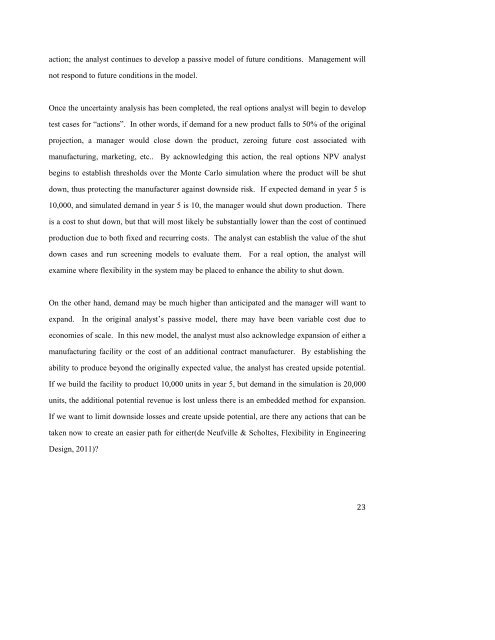A Case Study on Automotive Battery System Design - Title Page - MIT
A Case Study on Automotive Battery System Design - Title Page - MIT
A Case Study on Automotive Battery System Design - Title Page - MIT
- No tags were found...
You also want an ePaper? Increase the reach of your titles
YUMPU automatically turns print PDFs into web optimized ePapers that Google loves.
acti<strong>on</strong>; the analyst c<strong>on</strong>tinues to develop a passive model of future c<strong>on</strong>diti<strong>on</strong>s. Management willnot resp<strong>on</strong>d to future c<strong>on</strong>diti<strong>on</strong>s in the model.Once the uncertainty analysis has been completed, the real opti<strong>on</strong>s analyst will begin to developtest cases for “acti<strong>on</strong>s”. In other words, if demand for a new product falls to 50% of the originalprojecti<strong>on</strong>, a manager would close down the product, zeroing future cost associated withmanufacturing, marketing, etc.. By acknowledging this acti<strong>on</strong>, the real opti<strong>on</strong>s NPV analystbegins to establish thresholds over the M<strong>on</strong>te Carlo simulati<strong>on</strong> where the product will be shutdown, thus protecting the manufacturer against downside risk. If expected demand in year 5 is10,000, and simulated demand in year 5 is 10, the manager would shut down producti<strong>on</strong>. Thereis a cost to shut down, but that will most likely be substantially lower than the cost of c<strong>on</strong>tinuedproducti<strong>on</strong> due to both fixed and recurring costs. The analyst can establish the value of the shutdown cases and run screening models to evaluate them. For a real opti<strong>on</strong>, the analyst willexamine where flexibility in the system may be placed to enhance the ability to shut down.On the other hand, demand may be much higher than anticipated and the manager will want toexpand. In the original analyst’s passive model, there may have been variable cost due toec<strong>on</strong>omies of scale. In this new model, the analyst must also acknowledge expansi<strong>on</strong> of either amanufacturing facility or the cost of an additi<strong>on</strong>al c<strong>on</strong>tract manufacturer. By establishing theability to produce bey<strong>on</strong>d the originally expected value, the analyst has created upside potential.If we build the facility to product 10,000 units in year 5, but demand in the simulati<strong>on</strong> is 20,000units, the additi<strong>on</strong>al potential revenue is lost unless there is an embedded method for expansi<strong>on</strong>.If we want to limit downside losses and create upside potential, are there any acti<strong>on</strong>s that can betaken now to create an easier path for either(de Neufville & Scholtes, Flexibility in Engineering<strong>Design</strong>, 2011)?23
















